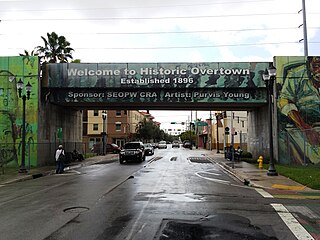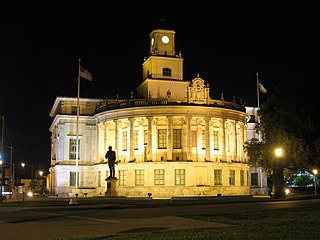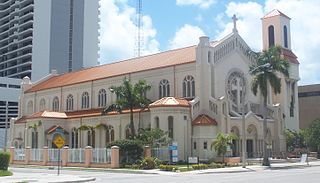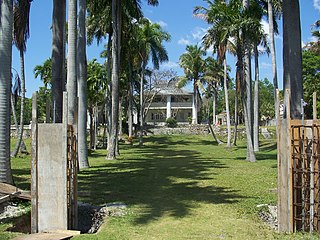
Miami Springs is a city in Miami-Dade County, Florida, United States. The city was founded by Glenn Hammond Curtiss, "The Father of Naval Aviation", and James Bright, during the famous "land boom" of the 1920s and was originally named "Country Club Estates". It, along with other cities in Miami-Dade County such as Coral Gables and Opa-locka, formed some of the first planned communities in the state. Like its counterparts, the city had an intended theme which in its case, was to reflect a particular architecture and ambiance.

Coconut Grove, also known colloquially as The Grove, is the oldest continuously inhabited neighborhood of Miami in Miami-Dade County, Florida. The neighborhood is roughly bound by North Prospect Drive to the south, LeJeune Road to the west, South Dixie Highway and Rickenbacker Causeway to the north, and Biscayne Bay to the east. It is south of the neighborhoods of Brickell and The Roads and east of Coral Gables. The neighborhood's name has been sometimes spelled "Cocoanut Grove" but the definitive spelling "Coconut Grove" was established when the city was incorporated in 1919.

The Freedom Tower is a building in Miami, Florida. It was designed by Schultze and Weaver and is currently used as a contemporary art museum and a central office to different disciplines in the arts associated with Miami Dade College. It is located at 600 Biscayne Boulevard on Miami Dade College's Wolfson Campus.

Overtown is a neighborhood of Miami, Florida, United States, just northwest of Downtown Miami. Originally called Colored Town in the Jim Crow era of the late 19th through the mid-20th century, the area was once the preeminent and is the historic center for commerce in the black community in Miami and South Florida.

The Miami Beach Architectural District is a U.S. historic district located in the South Beach neighborhood of Miami Beach, Florida. The area is well known as the district where Italian fashion designer Gianni Versace lived and was assassinated by Andrew Cunanan, in a mansion on Ocean Drive. It is bounded by the Atlantic Ocean to the east, Sixth Street to the south, Alton Road to the west and the Collins Canal and Dade Boulevard to the north. It contains 960 historic buildings.

The Old U.S. Post Office and Courthouse is a historic courthouse in Miami, Florida. It is located at 100-118 Northeast 1st Avenue. Constructed over three years (1912–14), it was designed by Kiehnel and Elliott and Oscar Wenderoth. It was added to the U.S. National Register of Historic Places on January 4, 1989. The Miami-Dade County Tax Records say this building was built in 1917 .

The Cathedral Basilica of St. Augustine is a historic cathedral in St. Augustine, Florida, and the seat of the Catholic Bishop of St. Augustine. It is located at 38 Cathedral Place between Charlotte and St. George Streets. Constructed over five years (1793–1797), it was designated a U.S. National Historic Landmark on April 15, 1970. Its congregation, established in 1565, is the oldest Christian congregation in the contiguous United States.

St. Margaret's Episcopal Church and Cemetery is a historic Carpenter Gothic church and cemetery located at 6874 Old Church Road in Hibernia, on Fleming Island, near Green Cove Springs, Florida, in the United States. On June 4, 1973, the church and its cemetery, which is also known as the Hibernia Cemetery, were added to the National Register of Historic Places.

The Coral Gables Congregational Church is a historic Congregational church in Coral Gables, Florida, United States. The church was designed by the architect Richard Kiehnel of Kiehnel and Elliott in 1923 and is regarded as a fine example of Spanish Colonial Revival architecture. It is located at 3010 DeSoto Boulevard. On October 10, 1978, it was added to the U.S. National Register of Historic Places.

The Greater Bethel AME Church is a historic church in Miami, Florida. It is located at 245 Northwest 8th Street. On April 17, 1992, it was added to the U.S. National Register of Historic Places. The church was built in 1927. On February 12, 1958, Dr. Martin Luther King Jr. delivered a speech at the church, "Launching Of The SCLC Crusade For Citizenship."

The Riverside Baptist Church (RBC) is a Baptist church located in Jacksonville, Florida, at 2650 Park Street in the Riverside neighborhood. It is affiliated with the Association of Welcoming and Affirming Baptists, Alliance of Baptists and the Cooperative Baptist Fellowship.

The First Coconut Grove Schoolhouse is a historic school located in Coconut Grove, Florida. The school originally resided at 2916 Grand Avenue in Miami. The structure was built in 1887 by Coconut Grove pioneer Charles Peacock. Peacock reportedly constructed the house using wood gathered from ships wrecked in nearby Key Biscayne. The building originally served as a community gathering place, with Sunday School as its main purpose.

The Coral Gables City Hall is a historic site in Coral Gables, Florida. It is located at 405 Biltmore Way. On July 24, 1974, it was added to the U.S. National Register of Historic Places.

The Walgreen Drug Store is a historic site in Miami, Florida. It is found at 200 East Flagler Street.

Trinity Episcopal Cathedral in Miami, Florida is the cathedral church of the Episcopal Diocese of Southeast Florida. It is located at North Bayshore Drive and the Venetian Causeway near the Carnival Center in Miami. On October 10, 1980, it was added to the U.S. National Register of Historic Places.

The Central Baptist Church is a historic church in Miami, Florida. It is located at 500 Northeast 1st Avenue. On January 4, 1989, it was added to the U.S. National Register of Historic Places. On October 21, 2007, Central Baptist Church voted to merge with Christ Fellowship, originally named First Baptist Church of Perrine. The church was built in 1925.

The Trapp Homestead is a historic home in the Coconut Grove section of the City of Miami, Florida, United States. It is located at 2521 South Bayshore Drive. On November 10, 1994, it was added to the U.S. National Register of Historic Places. The home was constructed in 1887 out of oolitic lime quarried locally by Caleb Trapp and his son, Harlan. During construction, the Trapps lived on a thatched hut at the front of the property. The property is believed to be the oldest-standing masonry home in Miami-Dade County, Florida. The estate's construction pre-dates the incorporation of the City of Miami. The estate was particularly notable at the time because it was one of the few stone structures in Miami-Dade County, as nearly all structures in the area were built of wood at that time.

August Geiger was one of the most prominent American architects in South Florida from 1905 to the late 1940s. He experimented in Mission, Neo-Renaissance and Art Deco architecture, but is most noted for his works in the Mediterranean Revival style. A number of his works are listed on the U.S. National Register of Historic Places.

The David W. Dyer Federal Building and U.S. Courthouse, formerly known simply as the U.S. Post Office and Courthouse, is an historic United States Post Office and federal courthouse of the United States District Court for the Southern District of Florida located at 300 Northeast 1st Avenue in Miami, Florida. Built in 1931 of limestone, it is the largest such structure in South Florida.

The architectural firm of Kiehnel and Elliot was established in Pittsburgh, Pennsylvania, in 1906. The firm did substantial work in Florida, and moved to Miami in 1922. From 1926, it was known as Kiehnel, Elliot and Chalfant.























